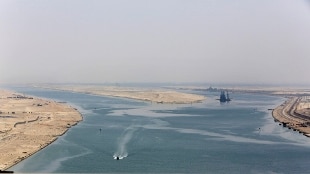Egypt, the Suez Canal doubles: celebration at the passage of the first ships
Pharaonic inauguration ceremony for the new Suez Canal
Work began on doubling the Suez Canal
Massari: the importance of the new Suez canal
The Aida in the Suez Canal
Share
06 August 2015 The official date of birth of the Suez Canal dates back to 1869, but the history of the most important motorway of the sea is actually much older, so much so that already in the classical world, and even earlier, the idea of uniting the two seas was longing in the mind of those who lived in those lands.
Indeed, the history of the Suez Canal begins several centuries ago.
The first plans for a waterway connecting the Red Sea to the Mediterranean seem to date back to
1850 BC, when the Pharaoh Sesostris III of the XII dynasty tried to build a waterway
east-west that united the Nile with the Red Sea for commercial purposes.
Then around 600 BC, another pharaoh, Neco II (or Nekau), embarked on the same undertaking but failed.
It was instead thanks to the Persian king Darius I, around 270 BC, that those works were resumed and completed.
Ptolemy II, Hellenistic pharaoh, restored it in 250 BC and in the following thousand years the line was modified, changed and destroyed several times.
In 30 BC, according to Plutarch in the Life of Mark Antony,
Queen Cleopatra of Egypt had tried to pass
what was left of her massive fleet, after the battle of Actium, through the Suez Canal, to gain access to the Red Sea. but nevertheless he did not succeed because the canal was now covered up.
In
1504 some Venetian merchants
proposed to the Mamluk sultans reigning in Egypt to connect the Red Sea with the Mediterranean by cutting the isthmus of Suez.
And this possibility was discussed in Ottoman circles throughout the course of the sixteenth century, especially in 1568 with the grand vizier Mehmed Pascià.
It will be necessary to wait for
Napoleon Bonaparte who in 1799 proposed
, during his expedition to Egypt, to resume the project of building a canal, but without succeeding.
A first survey, later revealed to be wrong, concluded that the difference in height between the two seas was over 10 meters and this would have required a system of locks.
In 1833 it was the turn of a French engineer, a follower of Saint Simon, who presented a project to the viceroy of Egypt Mohamed Ali, but it was not implemented.
Only after the mid-nineteenth century the work will finally be realized, thanks to Ferdinand de Lesseps, a French diplomat, who managed to obtain a concession from Said Pascià, viceroy of Egypt, to set up a company (Compagnie universelle du canal maritime de Suez), who built a maritime canal and operated it for 99 years.
In just over ten years,
between 1858 and 1869, the first modern Suez Canal was completed,
which connected the Mediterranean to the Red Sea, and then to the Indian Ocean, avoiding merchant ships having to circumnavigate Africa to travel between the Europe and the East Indies bringing enormous advantages in terms of time and costs.
The final project was drawn up by the engineer Alberto Negrelli.
On 17 February 1867 a first ship crossed it, but only on 17 November 1869 was it inaugurated in the presence of the French empress Eugenia.
Even before the construction of the canal, some transports were carried out on its route (not yet existing) by unloading the ships and transporting the goods by land from the Mediterranean to the Red Sea (and vice versa), where they were re-embarked.
In 1875, due to severe financial difficulties,
Ismail Pasha of Egypt sold the Canal share to England for 4 million pounds
.
Then in 1888 the Convention of Constantinople decided the neutrality of the sea route, free and open in times of war and peace to any civilian and military ship of any country.
During the Great
War
the Canal was closed to non-allied vessels by the French and British and in the Second World War it was defended during the North African campaign.
On July 26, 1956, Egyptian President Gamal Nasser announced its nationalization: at the time the management company was 44% controlled by British banks and companies and the other half by French.
In June 1967 it was closed during the Six Day War with Israel.
Eight years later, in 1975, with the withdrawal of Israeli troops from Sinai, President Sadat decided to reopen it.

